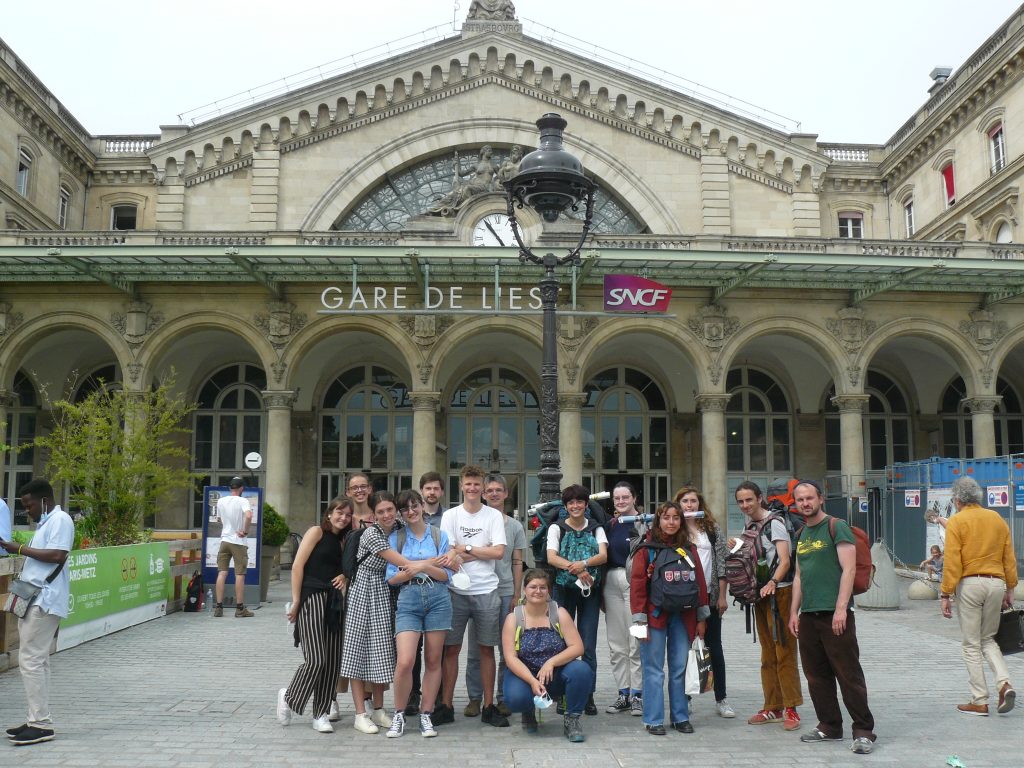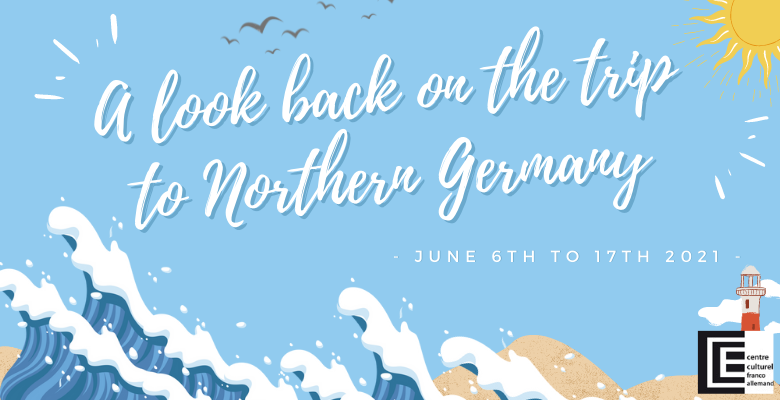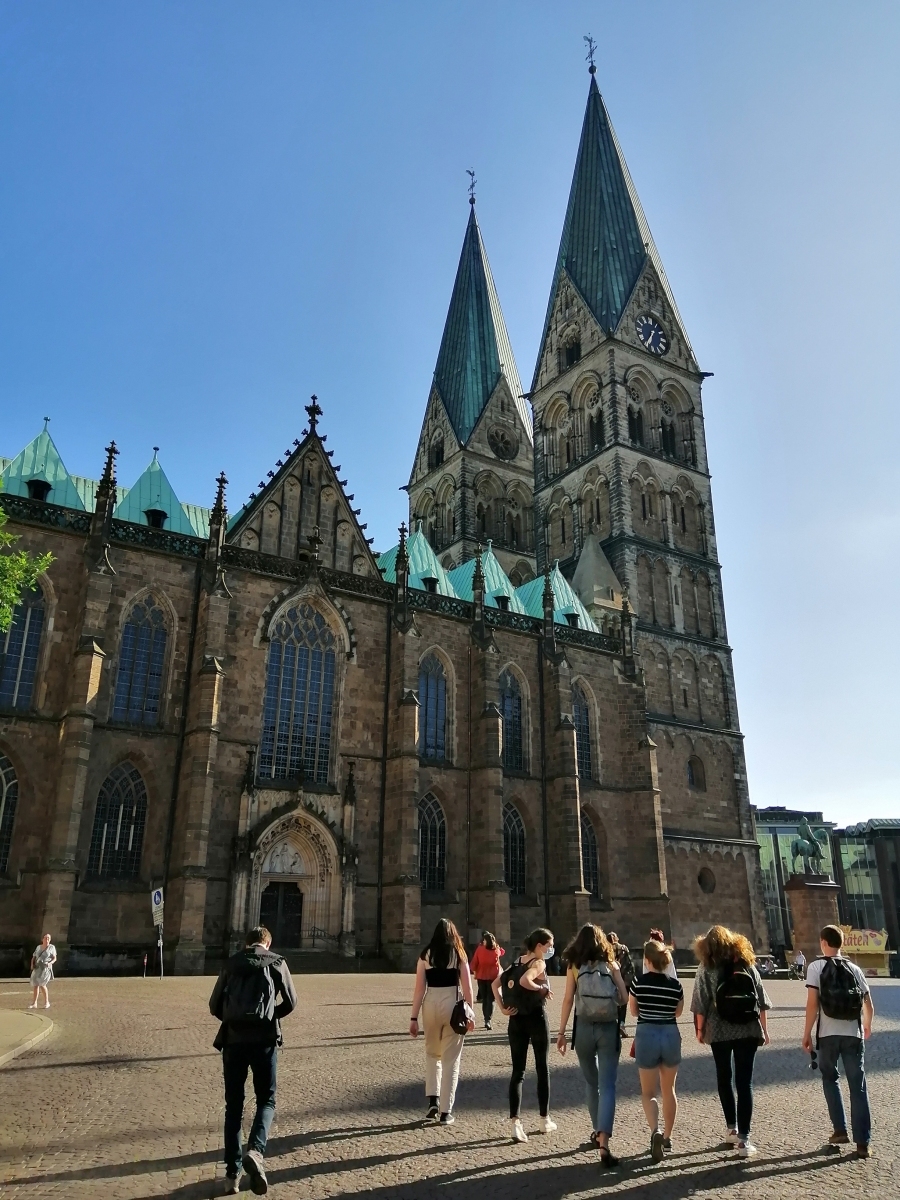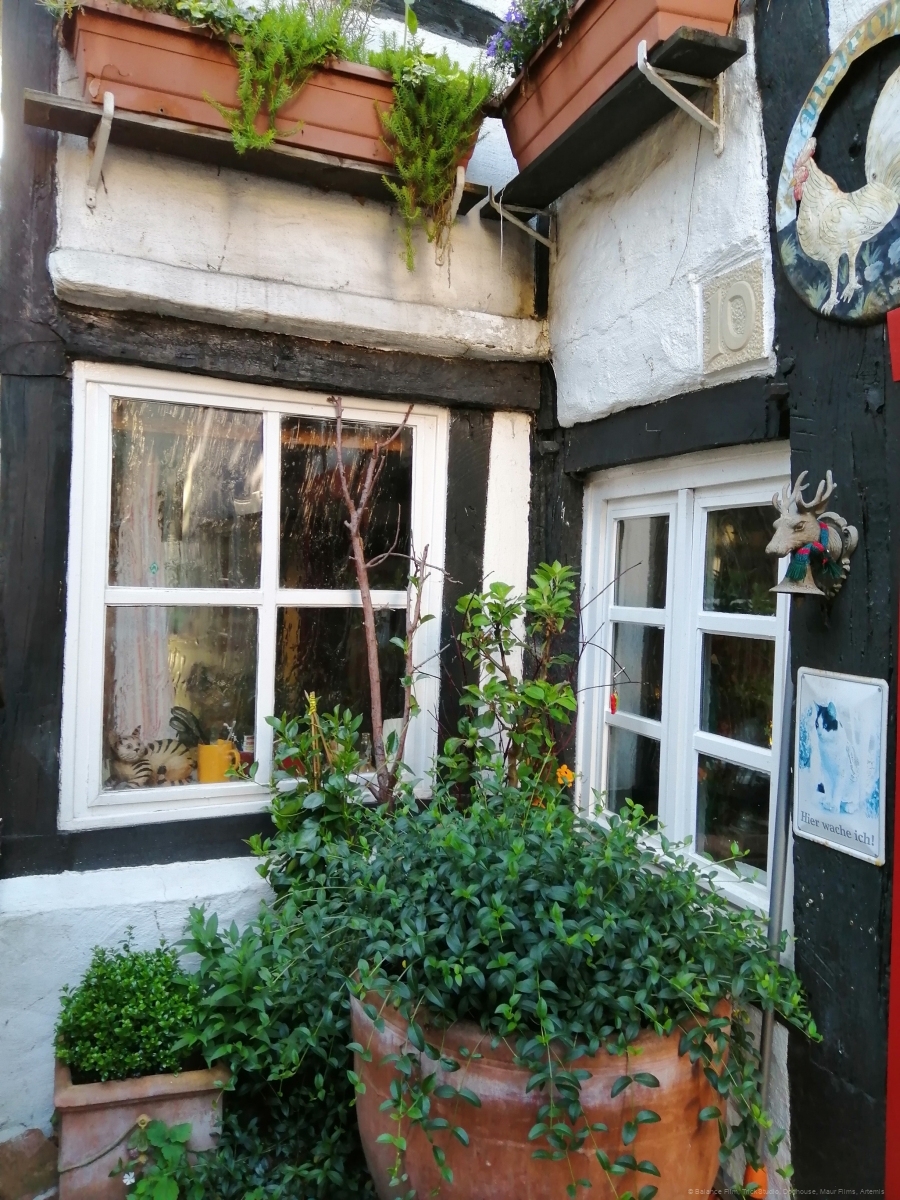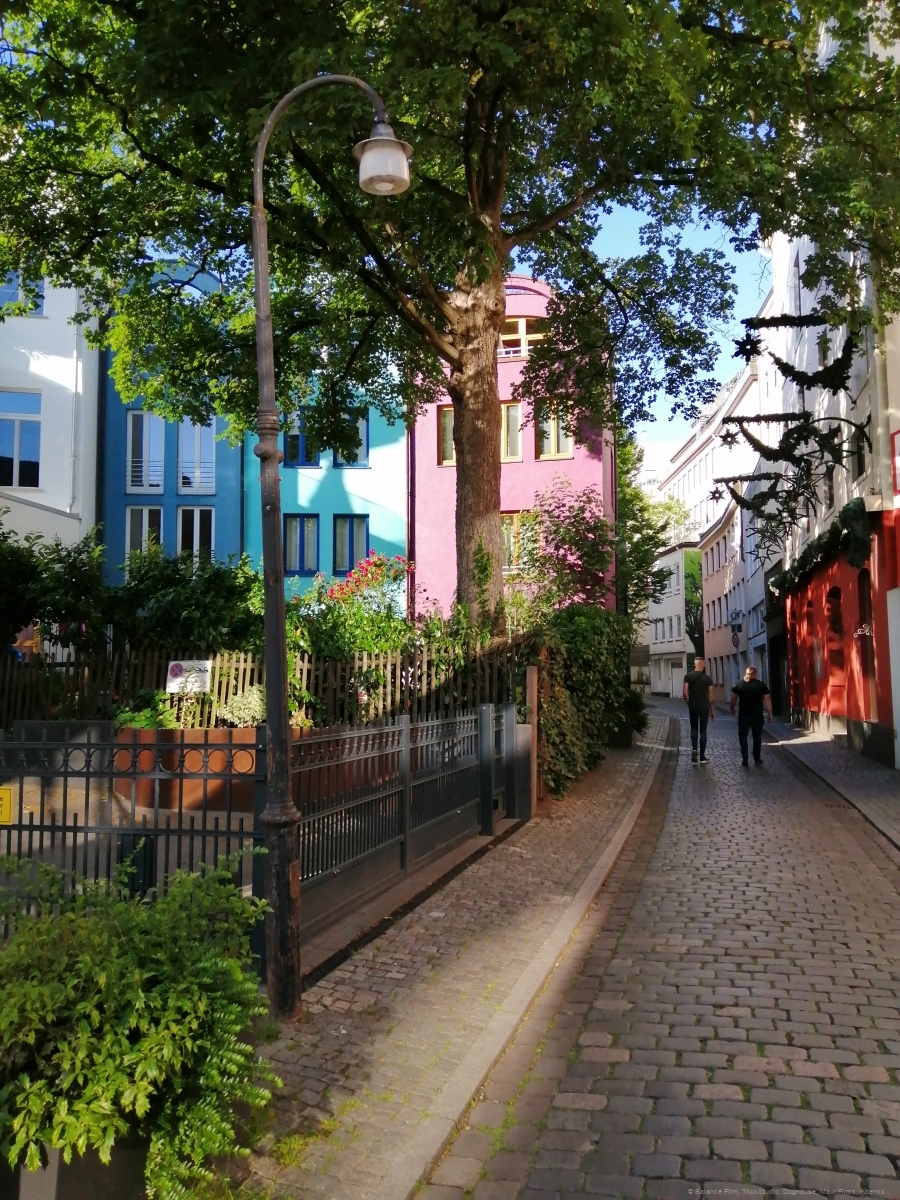Study trip to East Frisia
On the 6th of June, a group of students from the University of Nantes, accompanied by our director Martin Krechting and our DAAD linguistic assistant, Arne Hintz, traveled to the North of Germany for an itinerant journey along the coast. On their way there, they stopped over in Cologne: here is a memory of them in front of the Cologne cathedral!
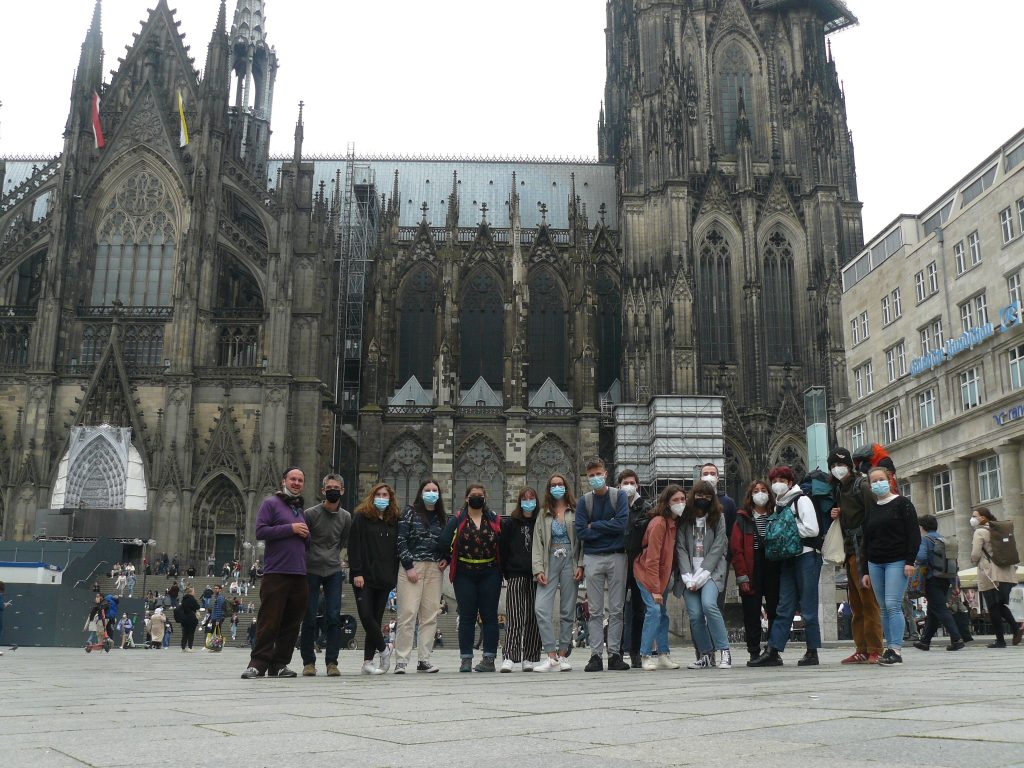
After arriving in the university town of Oldenburg on the night of Sunday June 6th, which was the first stage of their journey, the group began their morning on the 7th of June by discovering “Plattdeutsch” with a presentation and a workshop at the Heinrich Kunst Institute. It was followed by a rally through the streets of Oldenburg, prepared in collaboration with Etienne Légat, a German student at the University of Oldenburg, who warmly welcomed the group in his town of Oldenburg, and helped them eat at the university cafeteria even during a pandemic, and even showed them the campus of the Carl Ossietzy University in Oldenburg, before doing the rally at the end of the day.
On Tuesday the 8th, the group started the day by getting tested for COVID for the first time of their travel, a prerequisite condition to be able to visit the wonderful exhibition on the local jewish life at the Museum for Regional Art and History “Jüdisches Leben in Oldenburg”. After a small lunch on site, it was already time to go: the group left Oldenburg to go to the beautiful town of Jever; not to discover the beer of the same name, but to visit the Gröschler-Haus (“Zentrum für judische Geschichte und Zeitgeschichte der Region Friesland”), a center for jewish and modern local history of the Frisia region, where they were expected. When arriving in Jever, some members of the Gröschler-Haus were even waiting at the train station! After a walk in town, and learning more about the building and activities of the Gröschler-Haus, in the evening, the group left Jever to travel to the North Sea coast. A very busy day!
For the next three days, the group stayed in the small village of Werdum, a few kilometers from the coast.
The first morning, the alarm clock went off way too early for a hike through the mudflats, between the continent and the island of Spiekeroog: a 5AM start to avoid the tide, a really unforgettable experience on all accounts! After walking 12km through the mud, following a guide, the groupe arrived on the island of Spiekeroog; on the list for the day: exploring “soft tourism” and a guided tour of the national parks house of Wittbülten. The goal was to learn more about the sustainable development on the island. A very outdoorsy day!
The following day was also pretty full: after a bike rally along the coast to discover the region, the students took part in a presentation about the Shoah at the University of Bremen. Since the pandemic didn’t allow for an in-person participation to lectures in German universities, the students were able to follow online lectures at the department for Romance languages and cultures.
On the morning of June 10th, the group traveled to the next stage on their itinerant journey: the city of Aurich, where our colleague Arne Hintz came from. This leg of the journey was made by bus, Aurich not having a train station. In Aurich, the group had accommodation in the youth hostel, where they had to do a self-test for COVID, in order to be able to go on with the programme of their trip.
In the afternoon, before the COVID test, not long after arriving in Aurich, the group discovered the “Ostfrisische Landschaft” (a regional association for culture, science and education) where the director of the association presented the history and activities of the East Frisia region, and the role of his institution for the region’s identity throughout history. Our group of Nantais & Nantaises then went on to visit the Westerholt wind farm, in the suburbs of Aurich, which offers a rare opportunity: being able to climb on the platform of a wind turbine, culminating at 62m! And what more can we say about the architect of this platform? Norman Foster himself, also known for (among other things) the Reichstag’s dome in Berlin, or the “Carré d’art”, the Museum of Modern Art of Nîmes in France. There are only 2 platforms of this type in Germany and only 8 in the whole world! What a view from this up high!
After an overnight stay, Arne Hintz, Martin Krechting & their group left the town of Aurich and traveled by bus to the Moormuseum in Moordorg, before carrying on to Emden, the biggest city in the East Frisia region, and last stop before Bremen. A few days before, Emden was classified as high incidence zone for coronavirus, with more than 100 positive cases of COVID for 100 000 inhabitants, which meant that the group traveling there remained unsure for a long time. Once there, the city of Emden had recovered a bit of its liveliness, but many of its shops were still closed and many of its streets still deserted… The youth hostel was not even open to the general public yet, but the director insisted on welcoming the group herself, which meant that they had the hostel all to themselves! The evening walk along the harbor, on the paths following the water, gave a quick but beautiful overview of this city where the water seems to be everywhere.
In the morning, the group got tested again, in order to visit the Kunsthalle in Emden, the city museum that hosts, among other things, the Henri Nannen collection, an important figure in the world of journalism of post-WWII Germany. After having lunch, the group travel to Bremen in the afternoon: the final stage of their journey.
On the evening of June 13th, Melanie Blank, a former DAAD language assistant in Colombia, came to pick up the group in front of their accommodation near the train station, to take them on a first tour through the city, in the Schnoor & Viertel neighborhoods, where they had dinner. They then stayed in Bremen until their journey back to France on the 17th of June.
On the 14th, our colleagues Arne & Martin and their group took a day trip to Hamburg, to visit the Neuengamme concentration camp memorial, in the suburbs of Hamburg. The visit could be done alone or in small groups with an audioguide, which was very well done. For some of the participants, it was the first time visiting a former concentration camp, and the experience was overall very impressive for everyone. In the afternoon, the group went to Hamburg city center, where Martin Krechting, who had lived in Hamburg for a few years, took them on a little guided tour. After yet another COVID test for the next day’s programme, the group explored the University of Hamburg campus, before eating in the student neighborhood, and taking the train back to Bremen.
The second day in Bremen was actually spent outside of the city, this time in the port town of Bremerhaven, which is part of the city-state of Bremen. In Bremerhaven, the group went to the Klimahaus (Climate House) to learn more about the planet’s different climatic zones and the menace or rather the reality of climate change by going on a trip through the continents. From Bremerhaven, the group then went south to discover the artists’ village of Worpswede, known for its artists’ colony from the end of the 19th century to the beginning of the 20th century, whose most well known artist in France is probably Paula Modersohn-Becker. She had her first big dedicated retrospective in France a few years ago. The day then ended by an evening at the French Institute in Bremen, to follow the Germany vs. France football game. The group arrived a bit earlier at the Institute, and got a warm welcome by the Institute’s director Phanie Bluteau, who showed them a photography exhibition on the Valentin bunker, located in the district of Bremen-Farge, one of the external concentration camps of Neuengamme. By a very happy coincidence, the group also had the chance to meet Christel Trouvé, the scientific director of the Valentin bunker memorial, who was kind enough to explain to them the history of the bunker and the memorial’s activities.
The last day of the trip was themed around the colonial past of Germany in general and of the city of Bremen in particular. The group visited the Überseemuseum (Overseas Museum), a pioneering museum in the debate around the restitution of stolen artwork during the colonial period; afterwards, the group went on a very interesting guided tour of the Überseestadt district to discover the colonial past… On their way back to Bremen city center, the group could not pass up the Bremen Elephant: a monument formerly glorifying colonialism, before being designated as a monument against colonialism. To end not only the day, but also the whole journey, everybody had dinner at the Schlachte restaurant along the Weser, the river that goes through the city. After a night walk back to the hotel, suitcases had to be packed for an early 5:40AM departure… Once again, a great programme for this last day!
Finally, on June 17th, Martin Krechting, Arne Hintz & their group traveled back to Nantes after their rich and sunny two-week study trip to Northern Germany!
A big thank you to the German Academic Exchange Service (DAAD) and to the FLCE of the University of Nantes for their support, without which the trip could not have been a reality, and an eve bigger thanks to the wonderful group of participants who went along on this itinerant journey, which livelihood depended on the health crisis for a long time. Who would have thought it possible, even 15 days before the departure, that a journey to Northern Germany could have happened with all the participants coming back COVID-free and tanned…
